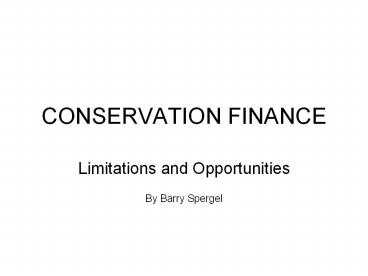CONSERVATION%20FINANCE - PowerPoint PPT Presentation
Title:
CONSERVATION%20FINANCE
Description:
Providing Economic Incentives for conserving biodiversity outside ... ineligible on political grounds ... Cruise Ship Passenger Fees. Dive Fees ... – PowerPoint PPT presentation
Number of Views:33
Avg rating:3.0/5.0
Title: CONSERVATION%20FINANCE
1
CONSERVATION FINANCE
- Limitations and Opportunities
- By Barry Spergel
2
Global Cost of Biodiversity Conservation
- 2 Main Components
- Financing Protected Areas
- Providing Economic Incentives for conserving
biodiversity outside protected areas - Current global spending on the first
- approx. 6 billion/year, need to increase to
45 billion - Current global cost of environmentally perverse
incentives and subsidies(especially for energy,
agriculture, fishing, forestry and mining) - over 1 trillion/year
3
Macroeconomic Solutions
- Reduce perverse subsidies
- Earmark part of the savings for biodiversity
conservation - Charge fees for environmental services and
earmark these fees for protected areas and
biodiversity conservation
4
All 3 Approaches will meet strong political
resistance
- By lobbies for each of the affected sectors
- By ministries of finance and IMF, which oppose
earmarking - Because of arguments that this will hurt the poor
- By competition for funds from other social
sectors - ---health, education,and poverty alleviation
- ---entitlement programs for aging populations
- ---expenses for defense/anti-terrorism
5
Economic Benefits of Biodiversityare OFTEN (but
not always)
- Hard to trace and quantify
- Speculative and in the future
- (e.g., bioprospecting)
- Hard to internalize costs by charging higher
prices - Difficult to standardize and trade biodiversity
as a commodity (cf. carbon emissions trading) - Provide environmental services which can also be
provided by industrial forestry (e.g. watershed
conservation and carbon sequestration) - Outweighed by non-economic values of biodiversity
(aesthetic, cultural, spiritual, moral,
psychological)
6
Difficult for the Private Sector to Make Money
from Biodiversity Conservation
- Look at the Experiences of private investors in
- Ecotourism
- Bioprospecting
- Organic Farming
- Private Protected Areas
- Frequent loss of money due to political risks,
economic risks, unpredictable natural events,
preference of investors for short-term returns - Therefore need forms of government insurance
(subsidies)
7
Traditional Sources of Funding for Biodiversity
Conservation
- National Government Budget Allocations
- International Donor Agencies
- Private Foundations
- International NGOs
- Protected Area Visitor Fees
- Probably only the last of these can be
significantly increased in the short term - Current entry fees are much less than most
visitors (esp. Intl. Visitors) willingness to
pay
8
Non-Traditional Finance Mechanisms that have
generated substantial revenues for
Conservation(over 500 million each)
- Bilateral Debt Reduction Agreements
- Lotteries
- Property Tax Surcharges for Land aquisition
(open-space conservation) - Property Tax subsidies for Giving Up Development
Rights (Conservation Easements) - Fees from Off-Shore Oil and Gas Leases
- Pollution Fines and Judicial Damage Awards
- Caveat But only if each of these is earmarked
for biodiversity conservation and protected areas
9
Impediments to Wider Use of Debt Reduction
Mechanisms for Purposes of Biodiversity
Conservation
- Western governments have already canceled most
bilateral debt of HIPC countries (more than half
of African countries), and most of their
remaining debt is owed to multilateral financial
institutions - Many debtor and/or creditor countries prefer to
use funds generated through debt reduction for
other social sectors - Some developing countries are suspicious that
debt reduction will infringe their sovereignty
and/or future development rights/options - Some creditor countries feel that debts of
certain countries (e.g. Russia) should not be
canceled but only rescheduled - other debtor countries ineligible on political
grounds
10
Non-Traditional Finance Mechanisms that have not
produced substantial revenues(although they may
be locally significant)
- Bioprospecting
- Commercial Debt-for-Nature Swaps
- Airport Fees
- Hotel Taxes
- Cruise Ship Passenger Fees
- Dive Fees
- Trophy Hunting Fees
11
Impediments to Wider Use of Lottery Revenues for
Conservation
- Many other competing social causes for these
revenues (health, education, art, science, social
services) - In many countries lotteries are either illegal or
considered immoral
12
Difficulties of Relying on Local Property
Property Tax Surcharges and Conservation Easements
- May be more appropriate for affluent areas
- Can be hard to enforce/maintain
- Some countries legal systems
- dont allow this
13
Impediments to Earmarking Fees from Oil and Gas
for Biodiversity Conservation and Protected Areas
- Political resistance by oil companies
- Other competing social priorities for these
revenues - Government policies or laws against earmarking of
revenues
14
Obstacles to Using Pollution Fines and Damage
Awards to Finance Conservation
- Not permitted under many legal systems money
cannot be earmarked but must go to the national
treasury - Punitive Damages not permitted in many legal
systems only compensation for direct damages - Political opposition/lobbying by oil companies

